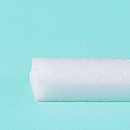ZI-201 PE Gasket (white)

Polyethylene Foam Gasket PE, white
Possible Applications
PE Gasket 6 × 4 mm, white (Art. Nr. F13V-1001)
PE Gasket 8 × 5 mm, white (Art. Nr. F13V-1002)
PE Gasket 10 × 6 mm, white (Art. Nr. F13V-1003):
for all rectangular flanges,
for most access doors with PE
PE Gasket 12 × 10 mm, white (Art. Nr. F13V-1004):
for very large or inaccurately cut airducts
for some large ccess doors with PE
Material
Closed cell and cross-linked polyethylene foam applied on a fibrous web fitted on both sides with an acryl dispersion adhesive.
Surface: rough and porous
Color: white
Without Silicone: yes (*)
Without Halogene: yes
Without polytetrafluor-ethylene: yes
Adhesive
Acryl dispersion (Acrylat copolymer).
Protective foil: siliconized film (*), brown.
(*) Self-adhesive products are usually fitted with a siliconized protective foil applied over the bounding surface. To install the product this foil must be removed: it is therefore not part of the product. The gasket material itself is silicon-free. It is possible however, that silicon traces are detected, as they can be transmitted to other parts during handling operations. An absolute silicon-free guarantee can, for that reason, not be given.
Operating Temperature
From ≈ -40°C to ≈ +70°C (≈ +80°C temporarily)
Compression Set
40% to 50% at +23°C
100% at +70°C
Behavior under Fire
Building Material Classification : B3, easily inflammable. Burns with dropping, bright flames and continues burning after removing the flame source.
Fire resistance: not suitable.
Smoke emissions: relatively low.
Food Industry
Physiologically harmless. Not suitable for contact with food as the adhesive does not comply with the FDA regulations.
Outdoor Exposure
Weathering and UV Resistances (DIN 53 386): light embrittlement of the surface.
Ozone resistance (DIN 53 509): cracking level 0.
Resistances to Chemicals
Chemicals and oils are available in very different qualities. Their properties vary depending on their concentration, operating temperatures, possible mix with other chemicals and the eventual presence of impurities. This is why gasket manufacturers only provide general information about the resistance of their products to various chemicals. The acrylate dispersion adhesive has a relatively low resistance to chemicals. In view of the above it is advisable that the client runs some tests in order to assess if the gaskets are suitable for the intended application. Please also note the somewhat limited life expectancy of elastomers due to aging. Controls at regular intervals are recommended. We regret not being able to provide more precise information.
REACH
Does not contain any substances (SVHC) which could be of concern according to the REACH extended list dated 13-01-2010. The product is therefore REACH compliant.
VDI 6022
Not applicable, as the entire installation along with its filters must be assessed. According to our knowledge, there are no particular testing instructions applicable to the individual components (i.e. gaskets). There are furthermore no cases known where the use of such a product in ventilation systems lead to the noncompliance with the directives.
PWIS
Please refer to the ZI-102
Important Information
The present additional information have been compiled carefully. They are only indications intended to provide counsel. They are the result of internal tests and information provided by our suppliers. There is no guarantee for completeness and accuracy. More precise information can only be made available through focused tests on a case by case basis. The provided indications do not discharge the user from conducting his own tests. Please make sure that the product is suitable for the intended use. Changes, errors and omissions excepted. Free translation: the German version prevails.
